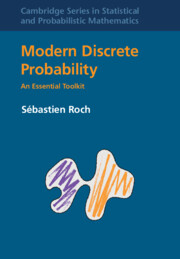4 - Coupling
Published online by Cambridge University Press: 14 December 2023
Summary
In this chapter, we move on to coupling, another probabilistic technique with a wide range of applications (far beyond discrete stochastic processes). The idea behind the coupling method is deceptively simple: to compare two probability measures, it is sometimes useful to construct a joint probability space with the corresponding marginals. We begin by defining coupling formally and deriving its connection to the total variation distance through the coupling inequality. We illustrate the basic idea on a classical Poisson approximation result, which we apply to the degree sequence of an Erdos–Renyi graph. Then we introduce the concept of stochastic domination and some related correlation inequalities. We develop a key application in percolation theory. Coupling of Markov chains is the next topic, where it serves as a powerful tool to derive mixing time bounds. Finally, we end with the Chen–Stein method for Poisson approximation, a technique that applies in particular in some natural settings with dependent variables.
Keywords
Information
- Type
- Chapter
- Information
- Modern Discrete ProbabilityAn Essential Toolkit, pp. 182 - 255Publisher: Cambridge University PressPrint publication year: 2024
